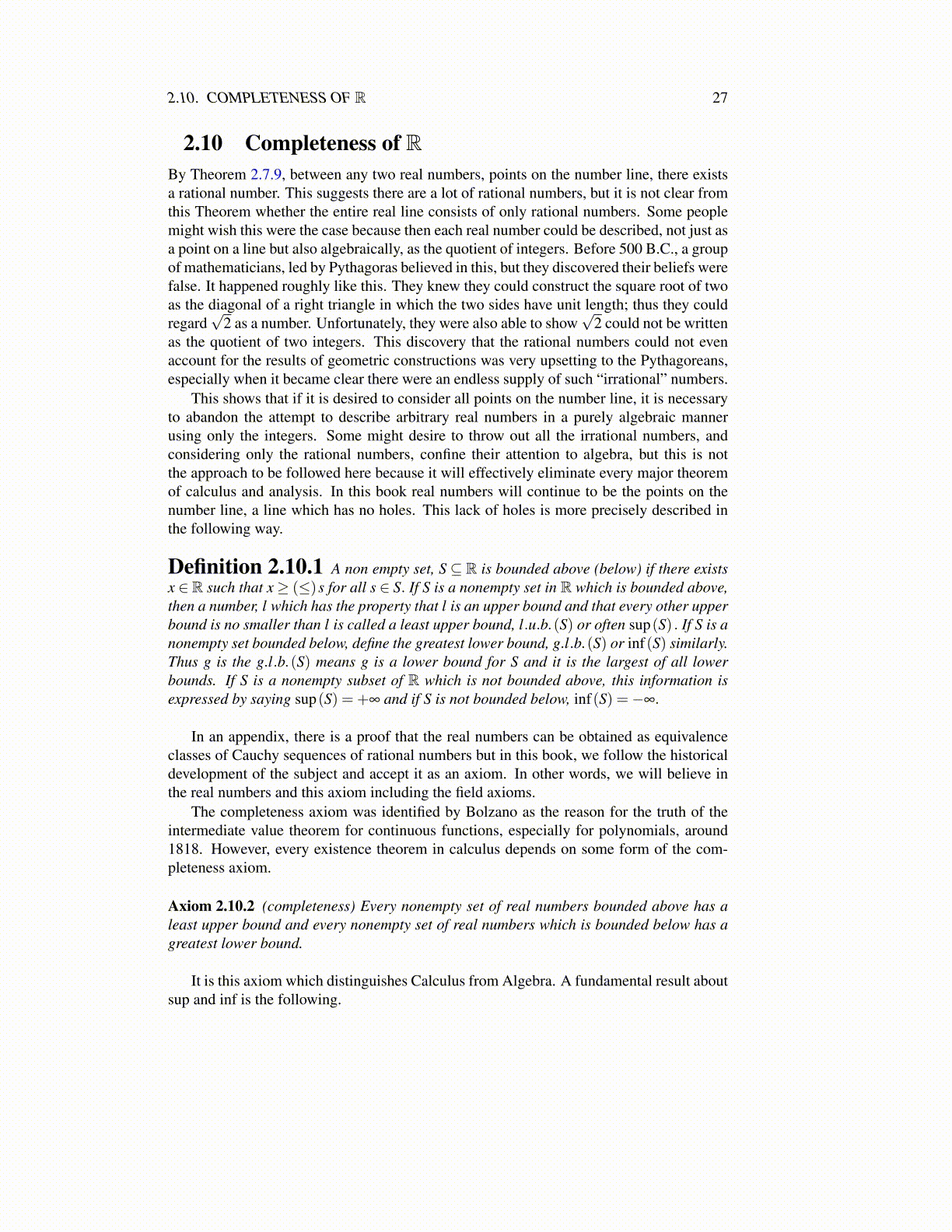
2.10. COMPLETENESS OF R 27
number line, a line which has no holes. This lack of holes is more precisely described inthe following way.
Definition 2.10.1 A non empty set, S ⊆ R is bounded above (below) if there existsx ∈R such that x≥ (≤)s for all s ∈ S. If S is a nonempty set in R which is bounded above,then a number, l which has the property that l is an upper bound and that every other upperbound is no smaller than l is called a least upper bound, l.u.b.(S) or often sup(S) . If S is anonempty set bounded below, define the greatest lower bound, g.l.b.(S) or inf(S) similarly.Thus g is the g.l.b.(S) means g is a lower bound for S and it is the largest of all lowerbounds. If S is a nonempty subset of R which is not bounded above, this information isexpressed by saying sup(S) = +∞ and if S is not bounded below, inf(S) =−∞.
In an appendix, there is a proof that the real numbers can be obtained as equivalenceclasses of Cauchy sequences of rational numbers but in this book, we follow the historicaldevelopment of the subject and accept it as an axiom. In other words, we will believe inthe real numbers and this axiom including the field axioms.
The completeness axiom was identified by Bolzano as the reason for the truth of theintermediate value theorem for continuous functions, especially for polynomials, around1818. However, every existence theorem in calculus depends on some form of the com-pleteness axiom.
Axiom 2.10.2 (completeness) Every nonempty set of real numbers bounded above has aleast upper bound and every nonempty set of real numbers which is bounded below has agreatest lower bound.
It is this axiom which distinguishes Calculus from Algebra. A fundamental result aboutsup and inf is the following.
Proposition 2.10.3 Let S be a nonempty set and suppose sup(S) exists. Then for everyδ > 0,
S∩ (sup(S)−δ ,sup(S)] ̸= /0.
If inf(S) exists, then for every δ > 0,
S∩ [inf(S) , inf(S)+δ ) ̸= /0.
Proof: Consider the first claim. If the indicated set equals /0, then sup(S)− δ is anupper bound for S which is smaller than sup(S) , contrary to the definition of sup(S) as theleast upper bound. In the second claim, if the indicated set equals /0, then inf(S)+δ wouldbe a lower bound which is larger than inf(S) contrary to the definition of inf(S) .
The wonderful thing about sup is that you can switch the order in which they occur.The same thing holds for inf . It is also convenient to generalize the notion of sup and infso that we don’t have to worry about whether it is a real number.
Definition 2.10.4 Let f (a,b) ∈ [−∞,∞] for a ∈ A and b ∈ B where A,B are non-empty sets which means that f (a,b) is either a number, ∞, or −∞. The symbol, +∞ isinterpreted as a point out at the end of the number line which is larger than every realnumber. Of course there is no such number. That is why it is called ∞. The symbol, −∞ isinterpreted similarly. Then supa∈A f (a,b) means sup(Sb) where Sb ≡ { f (a,b) : a ∈ A} . Asimilar convention holds for inf .